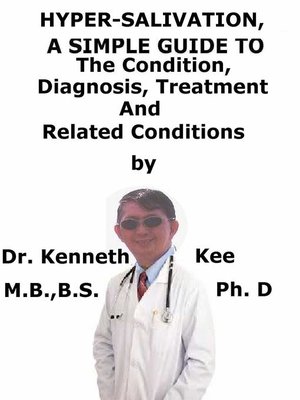Hyper-Salivation, a Simple Guide to the Condition, Diagnosis, Treatment and Related Conditions
ebook
By Kenneth Kee

Sign up to save your library
With an OverDrive account, you can save your favorite libraries for at-a-glance information about availability. Find out more about OverDrive accounts.
Find this title in Libby, the library reading app by OverDrive.



Search for a digital library with this title
Title found at these libraries:
| Library Name | Distance |
|---|---|
| Loading... |
This book describes Hyper Salivation, Diagnosis and Treatment and Related Diseases
Hyper-salivation (also called sialorrhea) is the excessive production of saliva.
It may also be produced by reduced clearance of saliva.
Hyper-salivation can cause excess salivation if there is an inability to maintain the mouth closure or difficulty in swallowing the excess saliva (dysphagia), which can induce excessive spitting.
Hyper-salivation also often happens before emesis (vomiting), where it accompanies nausea (a feeling of needing to vomit).
If the extra saliva starts to accumulate, it may start to drip out of the mouth unintentionally.
In older children and adults, hyper-salivation may be a sign of an underlying condition.
Hyper-salivation is when saliva does not intentionally flow outside of the mouth.
It can be produced by too much saliva production or weak muscles around the mouth
Hyper-salivation is normally caused by:
1. Disorders keeping saliva in the mouth (incontinence of saliva)
2. Disorders with swallowing (dyphagia)
3. Too much saliva secretion
Hyper-salivation may be transient or permanent depending on the cause.
If the person is dealing with an infection, the mouth may produce more saliva to help clear out the bacteria.
Hyper-salivation normally stops once the infection has been effectively treated.
Constant hyper-salivation (sialorrhea) often links back to an underlying disorder that involves muscle control.
This may be a sign before the diagnosis or a symptom that develops later on.
Some people with hyper-salivation disorders are at higher risk of breathing saliva, food, or fluids into the lungs.
This may produce harm if there is a disorder with the body's normal reflexes (such as gagging and coughing).
There are various frequent and harmless cases of hyper-salivation such as a numbed mouth from either Oragel or after going to the dentist office
Occasional hyper-salivation in healthy infants and toddlers is normal and may be related with teething.
It is not likely to be a sign of disease or complications.
Hyper-salivation in infants and young children may be aggravated by upper respiratory infections and nasal allergies.
Children can normally control hyper-salivation by 4 years of age.
Excessive hyper-salivation can be uncomfortable for parents and for the child at older ages.
Excessive hyper-salivation is frequent in children with cerebral palsy.
It can happen with other neurodegenerative diseases.
Excessive hyper-salivation is abnormal in the older, healthy child.
People with hyper-salivation disorders have a higher danger of breathing in saliva, food, or fluids into the lungs, particularly if hyper-salivation is due to a neurological problem.
If the body's normal reflex mechanisms (such as gagging and coughing) are not damaged, this is not life-threatening.
Temporary hyper-salivation is normally produced by:
1. Cavities
2. Infection
3. Gastro-esophageal reflux
4. Pregnancy
5. Certain tranquilizers and anticonvulsant drugs
6. Exposure to toxins, such as mercury
In these cases, hyper-salivation normally disappears after treating the underlying disorder.
Causes of decreased clearance of saliva are:
1. Infections such as tonsillitis, retropharyngeal and peritonsillar abscesses, epiglottitis and mumps
2. Problems with the jaw, e.g., fracture or dislocation
3. Radiation therapy
4. Neurological disorders such as Amyotrophic lateral sclerosis, myasthenia gravis, Parkinson's disease, multiple system atrophy, rabies,...







